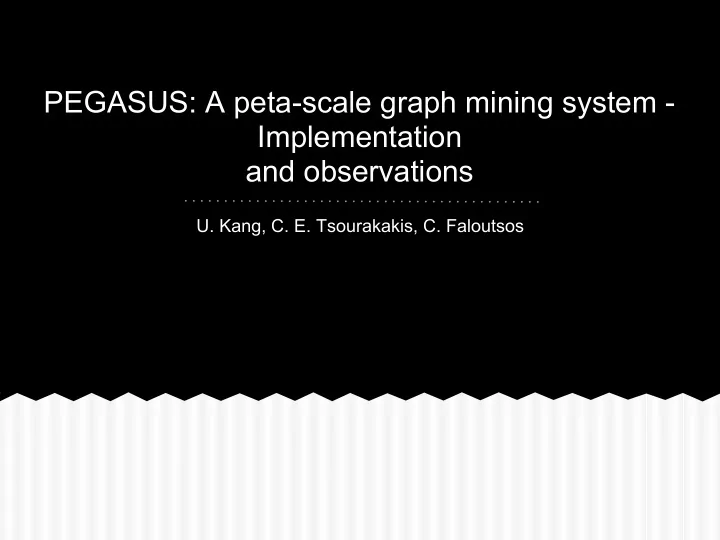

PEGASUS: A peta-scale graph mining system - Implementation and observations U. Kang, C. E. Tsourakakis, C. Faloutsos
What is Pegasus? ● Open source Peta Graph Mining Library ● Can deal with very large ○ Giga-, Tera-, Peta-byte ● Implemented on top of Hadoop ● several graph mining operations: ○ PageRank, Random Walk with Restart, Diameter estimation, Connected components ● Uses GIM-V (Generalized Iterated Matrix-Vector multiplication)
GIM-V Three Primitives (xG): 1) combine2(mi,j , vj ) : combine m i,j and v j . 2) combineAll i ( x 1 , ..., x n ) : combine all the results from combine2() for node i . 3) assign( v i , v new ) : decide how to update vi with v new . Iterative: ● Operation applied till algorithm-specific convergence criterion is met.
GIM-V - PageRank ● PageRank p of n web pages given by: p = (cE T + (1 − c)U )p c = Damping Factor (0.85) E = row-normalised adjacency matrix (src, dest)
GIM-V - PageRank (cont) ● Direct application of GIM-V ● Construct matrix M by column-normalise E T ○ each column of M sums to 1 ● p calculated by M xG p cur
GIM-V BASE ● 2-stage algorithm with 2 Map-Reduce in each stage ● Input: Edge and Vector file ○ Edge line : (id src , id dst , mval) -> cell adjacency Matrix M ○ Vector line: (id, vval) -> element in Vector V 1. Stage1 performs combine2() on columns of id dst of M with rows of id of V 2. Stage2 combines all partial results and assigns new vector -> old vector 3. The combineAlli() and assign() operations are done later in Stage2 4. Run iteratively until application-specific convergence criterion is met
GIM-V Block Multiplication (BL) ● Group elements of input matrix in submatrices of size b x b ● Group elements of vectors in length b ● Make them fit into 1 line of input file ● Only non-zero elements ● Forces nearby edges to be closely stored ● 5 times faster ○ Sorting time ○ Compression
GIM-V Cluster Edges (CL) ● Block Multiplication allows use of Cluster Edges ● Smaller number of blocks for input (if clustered) ● Preprocessing done only once, used in all further iterations
GIM-V Diagonal Block Iter (DI) ● Reduces runtime by reducing iterations-> less disk IO ● Multiplies diagonal matrix blocks and corresponding vector blocks ○ As much as possible in one iteration -> till content not change ● Pass id to neighbours located more steps away
Performance and Scalability ● Run Pegasus on M45 cluster by Yahoo! ○ In top 50 supercomputers ○ 1.5 Pb Storage ○ 3.5 Tb Memory ○ Used synthetic graphs (Kronecker)
Results - PageRank ● Running time decreases with more machines ● Clustering edges does not performed if not combined with Block Encoding ● Relative performance decreases with BASE as machines increase ○ (fixed costs) 3 machines 5.27x, 90 machines 2.93 ● All scale linearly with size of input
GIM-V DI vs BL-CL ● Used Connected Components ● Diameter 17 with 282M edges ● 6 Iterations vs 18
Real Graph Analysis # ● Power law tails in connected components ● Stable connected components after gelling point ● Absorbed connected components and Dunbar's number
Real Graph Analysis (cont) ● Anomalous connected components: ○ First Spike: Domain selling company -> sites replicated from same template ○ Second Spike: Porn sites disconnected from giant connected components (80%) ■ This are special purpose communities disconnected from rest of Internet
RGA - PageRank ● PageRank of YahooWeb follows a power law distribution with exponent 1.97, close to exponent 1.98 (from previous research in smaller networks) ● Observation holds true for 10,000 times larger network with 1.4 billion pages snapshot of the Internet
Diameter - Real Networks
Contributions ● Authors present new primitives to allow analysis of graphs ● Give various algorithms that operate with those primitives ● Several optimisations for the algorithms ● New results about very large networks
Critique ● Examples for the algorithms could have been more step-by-step ● The paper has a lot of information for its size (bit terse) ● Largest performance claim is based on using 3 machines?
Recommend
More recommend